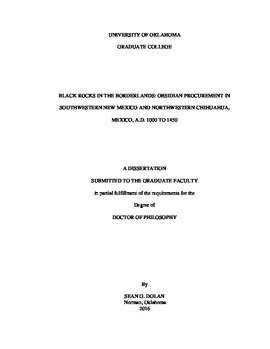| dc.contributor.advisor | Pitblado, Bonnie | |
| dc.contributor.author | Dolan, Sean | |
| dc.date.accessioned | 2016-05-16T16:25:33Z | |
| dc.date.available | 2016-05-16T16:25:33Z | |
| dc.date.issued | 2016-05-13 | |
| dc.identifier.uri | https://hdl.handle.net/11244/34704 | |
| dc.description.abstract | Over the past 50 years, geochemical characterization studies of obsidian artifacts from archaeological sites around the world have become an important way to examine long- and short-distance social interactions and procurement practices through time and across space. This is certainly the case for the North American Southwest and Mexican Northwest as there are approximately 40 to 50 known geochemically distinct obsidian sources on the landscape. As a result, precise identification of which sources people used is invaluable information to archaeologists interested in studying regional and temporal patterns of obsidian procurement.
In this dissertation, I establish the first regional context for obsidian procurement in southwestern New Mexico and northwestern Chihuahua, Mexico from A.D. 1000 to 1450. I accomplish this by discussing the results of an energy-dispersive X-ray fluorescence (EDXRF) analysis of over 1,000 obsidian artifacts from 26 archaeological sites. I supplement previous studies of obsidian procurement in southwestern New Mexico, by incorporating data from new sites and adding to the database of sourced obsidian artifacts. I also present the first well documented EDXRF study of obsidian procurement in the Casas Grandes region of northwestern Chihuahua during the Medio period.
The goal of this dissertation study is to examine variability in obsidian procurement through time and across space. Did people only use one or two types of obsidian, or was procurement more diverse which suggests that people extended their social networks to obtain different types of obsidian? The sourcing results demonstrate there are clear regional dissimilarities between the Mimbres Valley, the Deming basin and range, the Uvas Valley, the Animas Valley, and the Casas Grandes Valley from A.D. 1000 to 1450.
My research shows there are diverse strategies of obsidian procurement. People from some regions never changed their procurement tradition. On the other hand, some obsidian traditions fluctuated through time and people in the same geographic region used multiple sources of obsidian. By discussing the homogeneity and heterogeneity in obsidian procurement in the five culturally and environmentally diverse regions over a long period of time, I expose diverse social histories regarding obsidian procurement traditions at the temporal, regional, and site levels. By doing so, I have moved toward a more dynamic understanding of the mutually constitutive relationships that linked groups of people who shared a tradition of obsidian procurement in southwestern New Mexico and northwestern Chihuahua. | en_US |
| dc.language | en_US | en_US |
| dc.subject | North American Southwest, Obsidian, Mimbres, Casas Grandes | en_US |
| dc.title | Black Rocks in the Borderlands: Obsidian Procurement in Southwestern New Mexico and Northwestern Chihuahua, Mexico, A.D. 1000 to 1450 | en_US |
| dc.contributor.committeeMember | Gilman, Patricia | |
| dc.contributor.committeeMember | Suneson, Neil | |
| dc.contributor.committeeMember | Duwe, Sam | |
| dc.contributor.committeeMember | Minnis, Paul | |
| dc.contributor.committeeMember | O Neill, Sean | |
| dc.date.manuscript | 2016-05-12 | |
| dc.thesis.degree | Ph.D. | en_US |
| ou.group | College of Arts and Sciences::Department of Anthropology | en_US |
